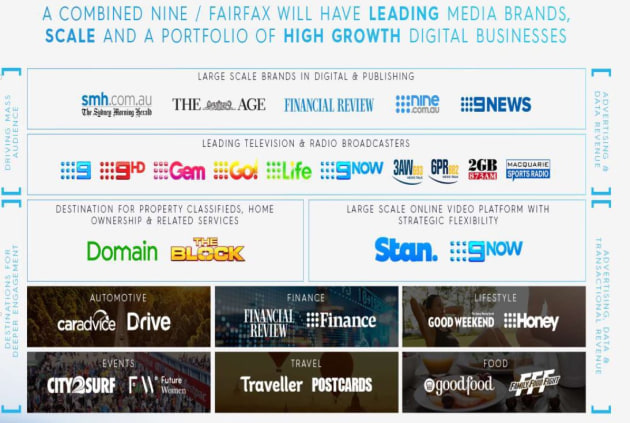
Fairfax CEO Greg Hywood has confirmed the company's heritage name will cease to exist following news of its merger with Nine, but masthead brands will be strengthened by the combined forces of the two media businesses.
He said mastheads like the Sydney Morning Herald, The Age and the Australian Financial Review, can benefit from a brighter future with the Nine/Fairfax merger promising a “more robust commercial model”.
Nine CEO Hugh Marks, who will lead the newly merged entity, agreed that the Stan and Domain assets, and not the journalism, were the primary motivator for the merger, but reaffirmed Nine’s commitment to carrying on Fairfax’s independent charter.
"The board is more than happy to adopt the principles of the Fairfax independence charter,” Marks said, speaking on an investor call today.
“If you spoke to any of our journalists you’d find our actions are entirely consistent with the charter.”
He also explained, on a separate media call, that Stan and Domain’s financial viability and potential growth generate Nine’s ability to invest in content and its newsrooms.
As for the future of Fairfax’s newspapers, Nine said there is no plans to axe any of the print publications or migrate the mastheads within Nine’s digital assets.
Marks did however admit there would be changes to duplicated functions, with redundancies expected to contribute towards a saving of $50 million over the next two years.
He said the cuts would come from support and backroom roles – expected to be finance and HR – rather than “core content creation” roles, such as journalists.
Hywood, who will depart the business in six months, also could not confirm his role in the newly merged entity, shirking questions if he’d move into a chairman position now Marks is taking the helm.
Launching just three years ago as a joint venture between Nine and Fairfax, content streaming platform Stan recently hit one million users and inked a series of new Hollywood deals. Marks said Stan’s success story is a testament to the “brand building capabilities” of the two businesses.
While staff have been surprised with the news, and some openly hostile towards the merger, it has long been mooted as one of the obvious moves in the media industry once the Government approved the media reforms.

A revolutionary ad offering
Marks said the merger will “revolutionise” the way Nine approaches its advertising in market, now offering a “marketing platform” rather than an ad solution, with assets across print, linear TV, TV on demand, radio, streaming, digital publishing and more.
He’s confident the merger will also help Nine deliver on its promise of addressable advertising in off network platforms and compete against the likes of Facebook and Google.
The deal, which makes Nine the biggest media company in Australia now worth $4bn, also promises advertisers huge scale and simplicity, which has already piqued the interest of media buyers.
AANA CEO John Broome also listed the company's new scale as a benefit to advertisers.
"We’re optimistic that the Nine-Fairfax merger will create more value for advertisers, but we still need to see more detail to ensure that the deal enhances, rather than diminishes, the consumer experience,” Broome said.
Australia, and the stock price, reacts
Fairfax shares have jumped to their highest level in seven years following the merger announcement. In the hours after the news hit the ASX, Fairfax shares were 12%, higher at 86.25 cents - their highest level since May 2011. Nine shares had dipped 8%, to $2.315.
Media commentators have mourned the loss of Fairfax's legacy with staffers questioning their future within the organisation. Media union, the Media, Entertainment & Arts Alliance (MEAA), has called for the ACCC to block the merger, claiming it's a bad move for democracy, and former Prime Minister Paul Keating has savaged the merger, saying Nine has “the opportunism and ethics of an alley cat”.
The ACCC has announced it will launch an investigation into the merger, which will take three months. Marks said he couldn't see the deal not being approved by the competition watchdog.
"Certainly, on our analysis, you know, we feel confident that this is a transaction that should proceed," he said.
Paul Keating on the #Fairfax - #Nine merger - “This is an exceptionally bad development” #auspol #media @australian pic.twitter.com/UYrV3pirZ4
— Troy Bramston (@TroyBramston) July 26, 2018
Others, like minister Mitch Fifield and Prime Minister Malcolm Turnbull, have celebrated Nine and Fairfax for the evolution of the businesses.
Speaking on Tasmanian radio, Turnbull said he is supportive of the merger, which he credited to the government's media reforms approved last October.
"It will have to go through all of the regulator... the ACCC, but I understand the parties expect it not to face any regulatory hurdles," he said
"To be frank, I welcome the announcement. Fairfax is a great Australian company, a newspaper company. Nine Network of course is the first television station to be on air with Bruce Gyngall doing the first broadcast."
Fifield also credited his government of ridding Australian media of outdated laws, hindering. He said the proposed merger was an example of companies making use of that "historic" unshackling.
Have something to say on this? Share your views in the comments section below. Or if you have a news story or tip-off, drop us a line at adnews@yaffa.com.au
Sign up to the AdNews newsletter, like us on Facebook or follow us on Twitter for breaking stories and campaigns throughout the day.


